[youtube https://www.youtube.com/watch?v=xqA9BL3CJU0]
In this video I take a look at the different types of bench planes, and discuss options such as whether to have wooden or metal hand planes, which lengths of plane I prefer for different tasks, and generally have a good rant on the subject.
Choosing & Using Bench Planes.
Bench planes are one of the most fundamental parts of your hand tool kit.
They’re used for dimensioning your wood; hogging it down to thickness or width, flattening the surface, and planing edges straight and square.
Often we can make do without specialist joinery planes, tools like the fillister plane, or router plane which can make our work faster and easier, but which aren’t essential.
This introduction is focusing solely on the bench planes.
There are hundreds of different options out there, but you don’t need them all.
In fact when you get started you can cover all of your needs with only one. I’ve done another rant about the one hand plane I’d choose for getting started with. You can learn which plane it is, and how to set it to use throughout your woodworking here.
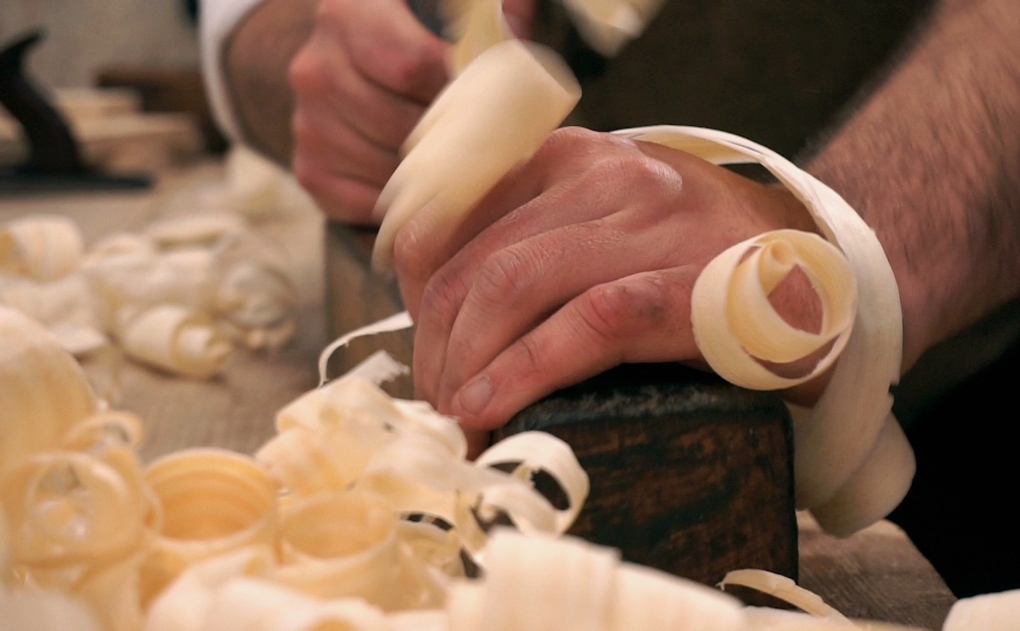 Using Hand Planes – The Best Plane For The Job
Using Hand Planes – The Best Plane For The Job
Whilst bench planes have always been named with a reference to their intended use, for example the ‘smoother’ is for smoothing, and the ‘jointer’ is for straightening edges to be joined, it’s not actually necessary to have all of the different types of plane to do your work efficiently.
Understanding what jobs you’ll need your planes to do will help you decide which route to take when setting up your kit.
From Rough to Smooth.
Obviously it’s the depth of cut that will dictate how heavy your shavings are, but there are other factors to think about when optimising for either very heavy stock removal, or very light polishing shavings.
Iron camber – this is where you put a radius to your iron’s cutting edge. Generally, for heavy stock removal you’ll want a heavy camber, whilst for smoothing, or edge jointing, an almost straight cutting edge, with just the very corners removed is best.
We’ll cover iron cambers & how to set them up in more detail shortly, so remember to check back to learn more.
Mouth Width – For thick shavings to clear the plane you’ll need a fairly wide mouth, but this can actually be a problem on a smoothing plane, where a wide mouth will cause tear-out and prevent you from getting a clean finish.
Tear out can actually be controlled in other ways – by using a high angle plane, or, if you have a double iron / cap iron on your plane, then this can be set as a very effective tear out control.
Flattening & Straightening.
Sole flatness and sole length are two factors that determine how well a hand plane will flatten a board or straighten an edge. The other factor is the skill of the user, and generally the longer and flatter a plane is, the less skill will be required for straightening and joining edges.
For general board flattening, a Jack plane, or Stanley style No 5 is a good length to go for.
A longer jointer plane isn’t essential, however I do recommend one if you’ll have a lot of long boards to straighten as it’ll make your life so much more satisfying, and so much less frustrating.
I prefer a small smoothing plane if I’m choosing a dedicated plane for this job. I explain all of my reasons for that here, but even if you don’t want to go tiny, your smoothing plane will be the shortest of your bench planes, as it requires no straightening properties.
New, Old, Wooden or Metal Planes?
There’s no denying that metal planes over took wooden planes for a reason, but I remain a massive wooden plane user and always will.
The video at the top of this page offers some insight in to the reasons why you might choose to go one way or the other with your own bench planes.
Below are some of the practical reasons that make it likely you’ll consider a combination of both wooden and metal planes as you get started with hand planing.
Restoration
Hand planes can be one of the most expensive parts of your tool kit, and so for a lot of people getting started, buying second hand will be best for the budget.
Wooden planes make an obvious choice here, particularly when it comes to the longer planes.
If you buy an old metal plane and the sole’s out of flat by even a little, then you’re going to need some expensive kit to get it true, and it’ll take a lot of rubbing back and forth to get there. That’s going to take a lot of time, and also gives plenty of opportunity for error – you could easy rub a curve in to the plane’s sole.
Wooden planes on the other hand can be flattened using shorter bench planes, and this process is extremely fast compared.
Bear in mind that a flat sole is essential on a long jointer plane, whose job is to straighten edges, but it’s not a problem if it’s out a bit on a shorter bench plane intended more for roughing work.
Versatility & Ease of Use
Metal planes make a better option for versatility, as one metal plane can be set up to take a wide range of shaving thicknesses. This is why if I could only have one plane, then my choice would be metal.
Metal planes are also easy to adjust. You can set them up on the fly whilst planing, using the lever to straighten up the iron, and turning the dial to alter the depth of cut.
Wooden hand planes come with a much steeper learning curve, and this is why I think they’re far less popular today than the metal. When learning to use wooden planes, I’d recommend starting out with a plane set for roughing, with a heavy camber. This makes it much easier to set the depth of cut, and allows you to get a feel for how they work, and using wooden planes is very much to do with feel. You have to position your hands, put weight in different areas and set the iron with taps from a hammer.
The video at the top of this page goes through a few more insights for when choosing bench planes.
If you’re ready to get started with some hand planing, then have a read though some of my initial thoughts for my process of flattening a board.
Or if you’re really serious about learning, consider one of our Premium Video Series. We go through each project in full detail, and always go from beginning to end using only hand tools, right from rough sawn boards.


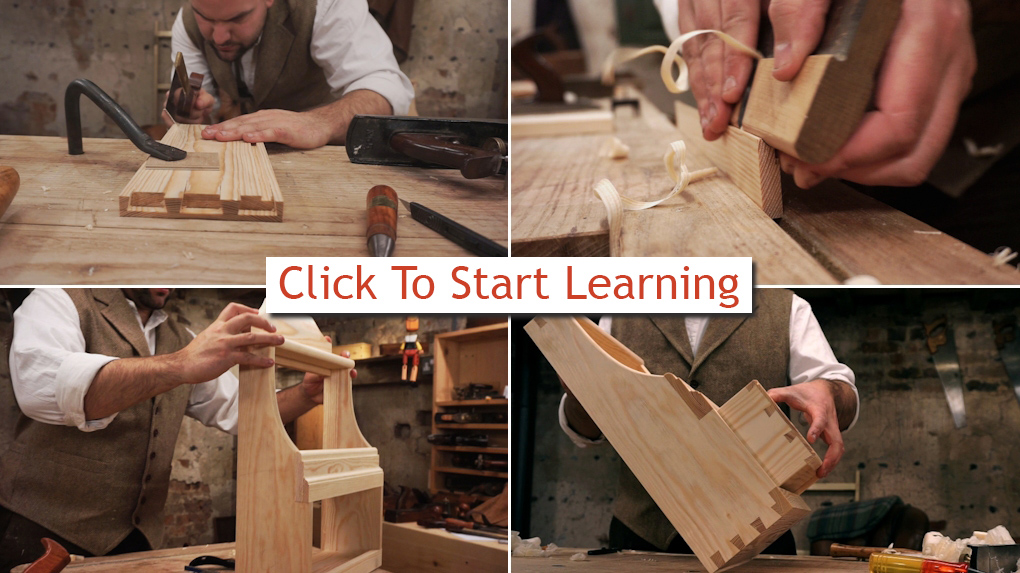
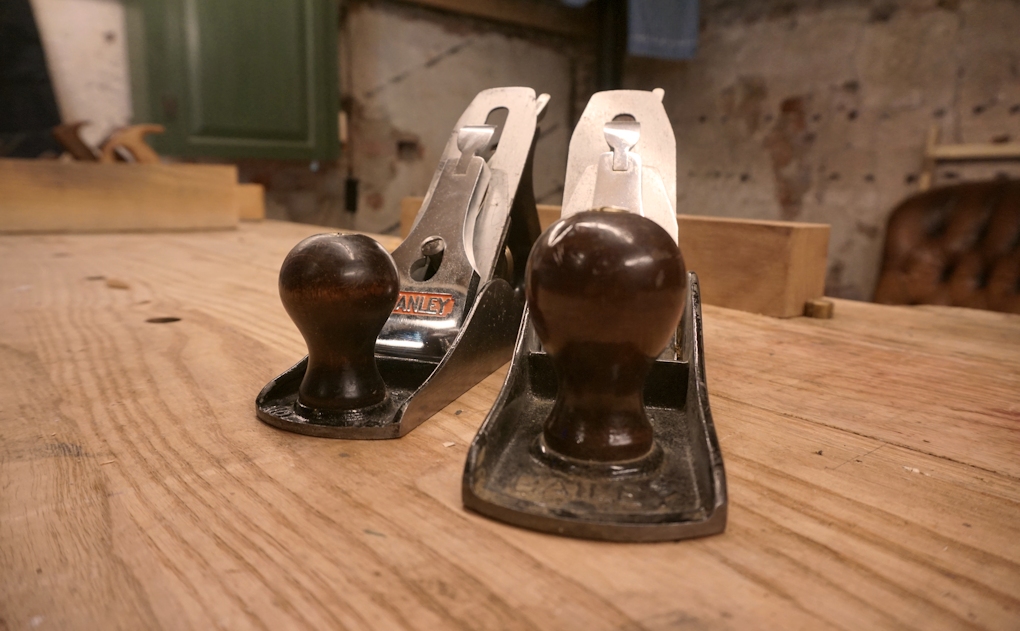
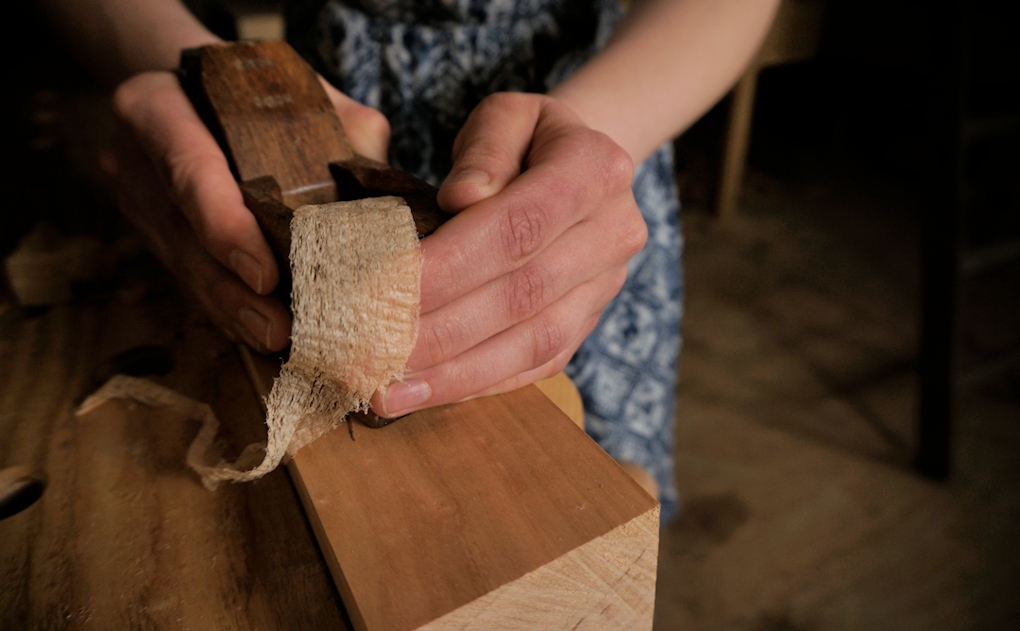
![Which Saws Are Best For Ripping Thick Stuff? [Video]](https://www.theenglishwoodworker.com/wp-content/uploads/2022/12/what-hand-saw-is-best-for-thick-rip-cuts.jpg)
![How do I Sharpen a Router Plane? [Q & A Video]](https://www.theenglishwoodworker.com/wp-content/uploads/2022/11/how-to-sharpen-a-router-plane-video.jpg)
![Bench Top Edge Jointing [with Video]](https://www.theenglishwoodworker.com/wp-content/uploads/2022/10/bench-top-edge-jointing-video.jpg)
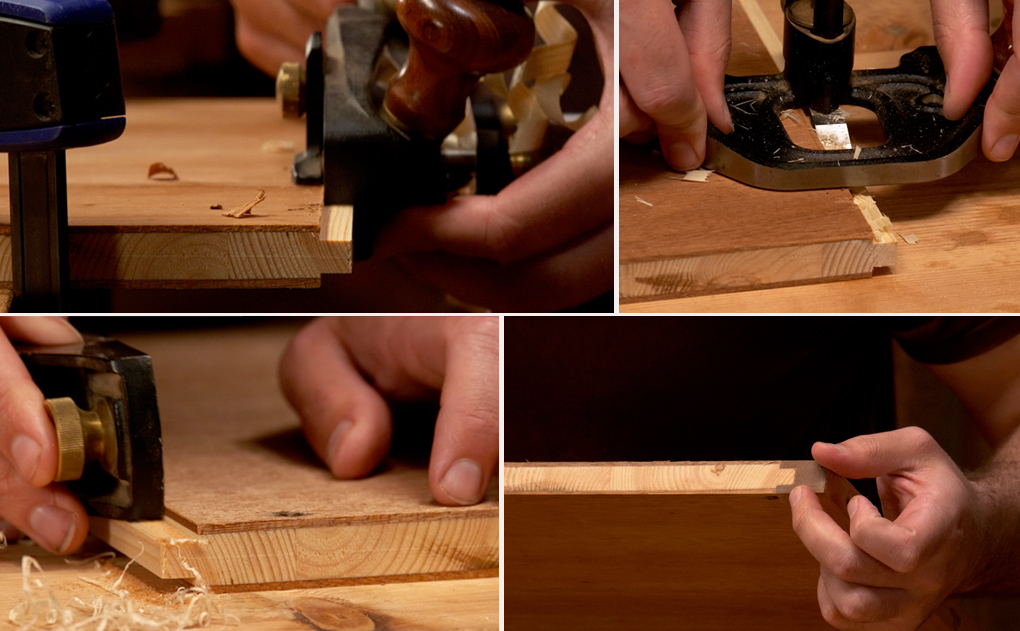
Hi Richard.
I never could get on with wooden planes, even though they were still in common usage by the older craftsmen when I started in the 1950s.
I found woodies clumsy, and I never really acquired the expertise of setting them. So my woodwork mentor grudgingly allowed me to use his metal planes; only after he reckoned I had proven I could use them. So it’s horses for the proverbial as I see it. I started my collection of metal planes right then and there!
Cheers and all the best.
Clumsy is actually a really good wood to describe them – like wearing a pair of clogs!
I am really starting to get into watching these video releases and find that they are making me want to get more into wood and hand tools. Just need to find some good planes (hard to find locally) and get into the shop and learn.
Hi Daryll, that’s very nice to hear. Now the weather’s starting to warm I hope you manage to find plenty of time to get in to the workshop.
I like both to be honest, pros and cons with both I suppose. Richard when you do the planning video, any chance you could quickly touch on my failing of sometimes planing a taper into the board.
Cheers buddy, nice video 😉
I’ve a few thoughts on the tapering and will certainly try to touch on them in a demo for you.
Thanks Richard 😉
Very good video. I like how you clarify that each wooden plane should be considered for a specific application and the reasons for it. Also the fact that the wooden soles have a burnishing benefit to the surface.
I have a question about how you set up for your video: do you have helpers? It looks like there are a couple of cameras going. I would like to get into making videos and am considering how to go about it.
Hi Tico,
Helen does all the filming. She sets up two cameras – they’re only cheapo ones but we find the two give a better result than having only one more expensive one. Don’t let tech spec or restricted knowledge get too in the way, like anything you learn by doing. If you have any questions drop us an email and we’ll try to help if we can. Best of luck.
I’ve never got on with wooden bench planes, probably because my hands are quite small and I find them uncomfortable to hold. Nevertheless, I found your video very interesting.
Thanks Paul.
As for planes, for beginners the metal ones are easier and flatter straight out of the box although it seems many want to get it ultra flat and tune it, something a beginner would find a bit excessive. A bit like buying a car, great as they are to drive, somebody will always want to tune the engine, stiffen the suspension, etc. I think you only appreciate that level of tuning when you are more experienced.
It’s also a valid point about wooden planes getting worn when planing narrow stuff like the edge of plywood as you mentioned. Metal wins there.
It’s going to come down to personal preference especially when you’re more experienced.
I’m no expert but while watching a demonstration by a Lie Neilson guy with all their beautiful planes, i asked if i bought one plane as a starter, which one would it be? He explained that they all do different jobs and i get the specialist planes, the shooters, the rebaters, etc but i wanted to know if i was starting, which general purpose plane would he recommend? I think we eventually got down to the 62 1/2 low angle bevel up plane as a good all-rounder. Needless to say, confused, I didn’t buy one.
I’m using an old Stanley no.4 with a Hock blade and a little Record block plane. When i know what direction i want to go, then i might appreciate all the different types. It’s only when you use them that you find their short comings.
As for radiused and straight blades, sharpening is a whole different video. Look forward to that one!
Beginning anything new is always daunting and I definately think the considerable variety of handtools makes woodworking one of the more confusing hobbies to get started in. We’re making a video soon about the ultimate starter plane from my perspective, that’s if I could only have one.
Hi Richard
I like the video and look forward to more of the same.
I don’t know whether you can explain this, but I recently had to plane a variety of timbers (Elm, Oak, Maple, Sapele and American Black Walnut) so thought I’d use my shiny new Lie Nielsen low angle jack to do this; however I found that whilst it was great for most of the timbers it didn’t like the elm (i.e. it was reluctant to even make a shaving) and I had to resort to my old Stanley jack plane. Why should one plane be good for some timbers and another be good for others?
Say Hi to Helen for me.
PS The wood burning stove looks inviting – wish I had one in my workshop. Great for toasting your sandwiches on!
Thanks Ian, the way different grains react can often be one of the many weirdo’s of woodworking. This could be one of those, if this was a bevel up plane then it’s likely down to the bevel angle, you can get massive performance differences by tweaking that. High angle on pine…you’re having a laugh. I tend to find that pine favours cheaper planes strangely, I always find my Stanley no. 5 runs circles around my Veritas Jack on pine.
i am really looking forward to your video restoring an old wooden plane. I’ve had a couple that I’ve carried around for years, never used them and didn’t know the first thing about setting one up. In particular, I had a devil of a time getting the blade out. Years of non use and rust had locked them in but I kept trying over the last year a finally got them free. So now what? Do I grind the blade? How should that blade fit? I should mention these are both the longer joiner style. I hope this is addressed when you do the restoration. I would really like to put these old guys into use.
Thanks Erik, we’ll definitely be addressing these time of issues through the restoration.
That was a lovely cha… er, rant… to watch on this very drizzly and chilly Friday, with the fire goin on in the back and such. I must look into repatriating at some point (only four generations removed; it’s still possible, right?) because if I’m to have drizzle and rain, I’d rather be surrounded by 300 year old stone cottages than vinyl siding.
The journey for me has always been with metal planes, because that’s really the only stuff you find what is usable, at least in my general area. Or if you do stumble upon a woody what’s in fine condition, it’s apparently a museum piece, if you judge solely on the asking price.
And that’s been true right up until the point I bought a moulding plane (a nice little 3/8 ogee) and managed to make it profile the edge of a shelf properly. Aw, that was nice. It was more than the shape I got, because I can get good profile shapes with things like my Preston beading planes I’ve such a love affair wi… I mean, that I like so much. It was the feel of wood-on-wood that was different, maybe.
So I’ve started coming around to wooden planes in a bit of a round about way. A few more moulding planes from a reputable supplier (so I knew they weren’t warped or otherwise unusable), a beading plane or two… more recently a wooden spokeshave. Then I suddenly find myself trying to fight this bug to kit my shop with wooden planes when I already have a nice (and small) selection of bench planes that suits me just fine.
A little while back, I spotted a rather fine wooden jack in an antique store in my home town. I managed to not buy it. Then texted my brother and asked him to stop by and pick it up for me. My reasoning was pretty much exactly what you said – that I might have good luck with setting up a coarse wooden jack first off and then I can consider working my way down to finer planes if I decide to go that route.
And if I don’t, then I wasn’t out but $15 and I maybe still have a good light plane for rough surfacing, which is necessary because I sold my 8″ jointer two weeks ago and don’t have any plans on replacing it, either.
Thanks for the excellent video, Richard. Looking forward to the next.
Cheers,
TKW
Many thanks, always enjoy your comments. Best of luck with that jack, try not to fight the bug too much, it always wins in the end.
Hi Richard,
Thanks for a really great video. You and Graham Haydon are doing a great job of introducing woodies to new audiences.
I have one small quibble, and one comment.
The quibble is that the cap iron doesn’t have to move (in relation to the blade) when the depth of cut is adjusted. I agree with you that many old planes have that problem, but not all of them. It should be regarded as a defect, not an inevitable feature.
The comment is that I was surprised you use a no.8 for flattening bench tops. I’m curious if you’ve tried using a large wooden trying plane for this. I guess one of the things I value most about woodies is the lighter weight. If I’m spending hours planing, a large woodie leaves me less tired than a heavy metal plane. But you’re a big guy, so maybe it’s not an issue for you!
Anyway, thanks, I’m looking forward to the next “rant.”
Thanks Steve,
In my experience the cap irons always move, even if it’s just marginally. I’m hitting it with a steel hammer after all. Just tried it on my Lie Nielsen… same result there.
Something I did forget to mention was the retraction of the blade, and these are all points which I’ll go in to in more detail when we do a video about using a setting a wooden plane.
For top flattening I came to favour the no. 8, mainly because of the momentum when you’re over reaching. For the first year of bench building I used a large woodie, the process became quite quick and I found the added weight of the metal to be a rare advantage.
Richard ,
Fascinating vid and looking forward to learning how to set up my collection of woodies. I just love the look and feel of these old tools.
Whatever the condition, old wooden planes always look the part 🙂
You do realize that when you get a bunch of these rants, you’re going to have to bundle them up on a DVD. First class knowledge you’re imparting. I’m really enjoying these videos. I cut a lot of bevels. My heavily cambered jack takes care of most of the work, and then my No. 7 cleans them up to a silky smooth finish. Can’t beat that heavy camber on the jack; it almost makes things too easy.
Thanks for the informative rant, Richard. I agree that there is room in the repertoire for both wood and metal bench planes. My own experience so far has been limited to metal, but I have been wanting to get into the wooden jack and smoothers for a while now. Every time I find a possible candidate at the antique store or the flea market I feel they are asking way too much for a tool that is in not good enough shape. They seem to think they are suitable for hanging on the wall, whereas I am looking for a fully working tool, or at least one that can be made so. My retirement budget doesn’t quite fit the desire to go out and buy one of the new tools from the few plane makers out there, as their asking price is more akin to their reputation as a tool maker than to my pocketbook. I have seriously considered making my own planes (I believe I have the skills to do so) but haven’t yet made the plunge. Mostly I could use direction is selecting the right plane iron(s). I again don’t need overkill, but still want a suitably durable and well wearing iron. Perhaps you can touch on these issues in your restoration video? Again thanks, love the videos, and am happy to be able to get them on this (the other) side of the pond.
You will look at wooden hand planes in a new light; go to Paul Sellers YouTube “Preparing a wooden jack plane”; he has very good videos on planes as well – no need to buy expensive planes – just tune them up; his Masterclass videos are excellent!
Thank you. A very clear explanation. I will no longer feel guilty or inferior for not using wood planes.
Hi Richard. These rants are brilliant. Kep them coming.
Hi Richard,
Another great post. Totally agree metal planes are more convenient and wooden planes give superior finish when set properly. I wonder why transitional planes (wooden sole with Bailey type iron adjusters) are hardly ever seen?. On the face of it they would seem to be a perfect compromise. I am tempted to acquire one to give it a wazz.Any thoughts?.
Hello Richard,
Another great video. But I don’t understand the trouble people have with wooden planes. Maybe because I was thought that way, we didn’t have metal planes at school. When I restarted wood working for a hobby I thought I would try a metal plane, because every one said how great they are. But I just don’t agree, I find them very troublesome to set up and use. I find wooden planes just much easier in use, give more feedback and glade nicer.
Thank you Richard! I want to point out the one gem of this rant I wish every blogging woodworker would take to heart: That the answer “whatever suits you is best” is pure crap! If I knew what worked best for me, I would not be asking! I love your videos and blogs. You’ve motivated me to end my 9 year hiatus from wood working. Shop is being built up again and I’ll be producing shortly!
When I started woodworking I was afraid of becoming discouraged at the outset by a plane that required a lot of adjustments. So, I saved up for a Lie-Nielsen low angle jack plane, and it has served me well. Someone with more patience might have benefited more from a Bailey style plane or a wooden plane. So, In that sense, I think that looking for a plane that you think will suit you personally does make sense. Thanks for the great videos and your tips.
Hey Richard – I love your bit on Planes. I do a bit of guitar work and I use a lot of little planes, an Ibex and a bunch of different ones I have made. Have you done anything with Chisel planes? A home made body and the iron is whatever chisel you have that is sharp enough. I’ve been looking for anything having to do with them mostly because I have chisels that I keep very sharp and would like to use one or two in a plane body. Any information would be nice to have.